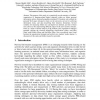1715 search results - page 2 / 343 » How Space Structures Language |
POPL
2000
ACM
15 years 3 months ago
2000
ACM
Distributed-memory programs are often written using a global address space: any process can name any memory location on any processor. Some languages completely hide the distincti...
102
click to vote
CORR
2006
Springer
14 years 11 months ago
2006
Springer
The organization and mining of malaria genomic and post-genomic data is important to significantly increase the knowledge of the biology of its causative agents, and is motivated,...
EDM
2009
14 years 9 months ago
2009
The purpose of this study is to empirically reveal strategies of students' organization of learning-related digital materials within an online personal information archive. Re...
107
click to vote
IIE
2007
14 years 11 months ago
2007
How do we teach children to express and communicate ideas in a formal and informal mode? What type of language do they need in a concrete context? How should they determine a prope...
DLT
2009
14 years 9 months ago
2009
A famous theorem of Kuratowski states that, in a topological space, at most 14 distinct sets can be produced by repeatedly applying the operations of closure and complement to a gi...


